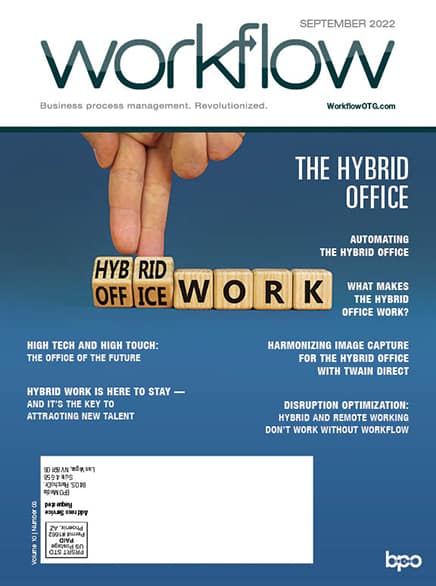
Christina Robbins, Digitech Systems
Over the last year or so, we have experienced historically high levels of job mobility and voluntary unemployment. But this unemployment wasn’t typical. Large numbers of individuals willingly left the workforce, which should lead us to question why. It’s my belief that the Great Resignation signaled historically low employee engagement. It’s a call for organizations to improve employee commitment and enjoyment at work.
How did we get here? The COVID-19 pandemic pushed millions around the globe into home offices, and many families realized that they did not need a second income, while other workers realized they did not actually enjoy the office environments where they’d been spending their days. Perhaps a difficult coworker, an unrealistic workload, or a lack of respect and recognition became apparent only when they were able to relax while working in healthier circumstances. Perhaps workers whose jobs were threatened by artificial intelligence and automation chose not to reskill in order to retain employment. The double-disruption created by COVID and automation has caused massive emotional stress for the workforce. The consequences of this decline in employee engagement are significant. Engaged workers make fewer mistakes, are more creative, demonstrate more pro-company behaviors, and ultimately increase financial results. Companies who fail to recognize and address job satisfaction will fall further behind in the race for top talent.
Both technology and people have a critical role to play in the high tech, high touch office of the future. Let’s take a look.
The role of technology
Technological advancements have been driving market growth and disrupting the workforce since the Industrial Revolution, and we can expect them to continue to do so.
Hybrid honors employee desire for flexibility
So much has been written about the hybrid office, work from home (WFH), and work from anywhere (WFX), that I’m not going to spend a lot of time on it here. Suffice it to say, that as adults, we crave flexibility, autonomy, and control across most aspects of our lives. It’s a healthy part of an adult psyche. Having experienced widespread WFH during the Pandemic, many workers understand that work location has little to do with effectiveness and productivity. Therefore, the hybrid office honors employee desire for flexibility without threatening a company’s performance. It’s a great way to ease the stresses of modern work for many jobs. In a Forrester webinar held in January of this year, Forrester CEO George Colony said, “We used to think the office was the toolbox. Now we know the office is just one tool in that box.”
Digital is just the foundation for business transformation
Our industry has spent a great deal of time and marketing dollars on “digital transformation” initiatives, but Valior reports that 90% of companies are more than half finished with their digital transformation, and Forrester indicates that only 15% consider it a critical objective for 2022. Though demand for imaging services will continue for some time to come, long-term print volumes will also decline, and available older paper files requiring imaging are limited.
Where might we turn next for transformative value? The future office will be highly automated, and workflow technologies are the foundation of automation. Workflow routes business information through business processes. It supports the WFX nature of work going forward, so automation technologies will be in high demand. They should be a core component of your product lineup.
Artificial intelligence vs augmented intelligence
Any discussion of the office of the future would be incomplete without considering the growing impact of artificial intelligence (AI). The World Economic Forum indicates that machines will be responsible for eliminating 85 million jobs by 2025, but they also say that the same shift toward AI will create 97 million new jobs in the same period. That’s a net gain in jobs.
What’s happening? AI automates routine manual tasks, which in most cases impacts only some aspects of a job. Most workers will need to reskill only some portions of their day-to-day work, and all of us will need to adapt to the new workforce diversity represented by humans alongside digital workers. It’s called augmented intelligence, referring to the genius that emerges when humans and computers work in complementary ways side-by-side. The office of the future will be one that still incorporates humans, but we can expect to see an increase in the digital workforce as well.
Human-centric is the next step to maximize value
Workplaces evolved as a way for people to come together to accomplish shared goals — a need that is likely to continue. So what makes a job attractive? According to “Boosting Your Emotional Intelligence,” appealing workplaces are characterized by meaningful work, supportive management, work that does good, growth opportunities, and trust in leadership. Each of these factors can be linked to two key ideas: a need for belonging and the importance of human-centric design.
The importance of connection and belonging at work
It may seem “touchy-feely” to some, but workers who have a strong sense of belonging with their workgroup are more productive, creative, and effective than their less-appreciated peers. According to Brené Brown, It’s not about the number of friends they have, but rather about feeling accepted and respected for their contribution. Workers who feel invisible and who frequently get ignored by colleagues and bosses are sometimes referred to as an “out group.” It turns out that in addition to being incredibly emotionally painful, being in the out group comes with significant health risks as well. Surgeon General, Dr. Vivek Murthy explains that loneliness increases the likelihood of early death by 45% (vs. air pollution 5%, obesity 20%, or alcoholism 30%). At work it decreases task performance, inhibits creativity, and limits effective executive functioning on tasks such as decision-making and reasoning.
Strategies to create a human-centric work experience
As the digital workforce grows, the stress on workers will increase alongside fear of job displacement and a need to reskill to remain relevant. Leaders must consider how they can ease this transition for their human workers and assist them in feeling seen and valued in the workplace. A few suggestions:
- Clarify roles for both your digital workforce and human workers, so task assignments are clear.
- Emphasize the value brought by humans that
cannot be found elsewhere or mimicked by machines. - Celebrate accomplishments by recognizing human contributions to successful projects and outcomes.
- Get your humans together! If office time is limited, organize regular social get-togethers or set a standard that requires staff to participate in person on a regular basis.
Conclusion
As more machines and improved AI technologies increase in the workplace, it becomes ever more important that leaders acknowledge the critical role leadership plays in the mental and emotional well-being of their employees. Responsible workplaces of the future will pair artificial intelligence with human intelligence in synergistic ways to improve outcomes for business as well as people. The future demands both high tech and high touch.




